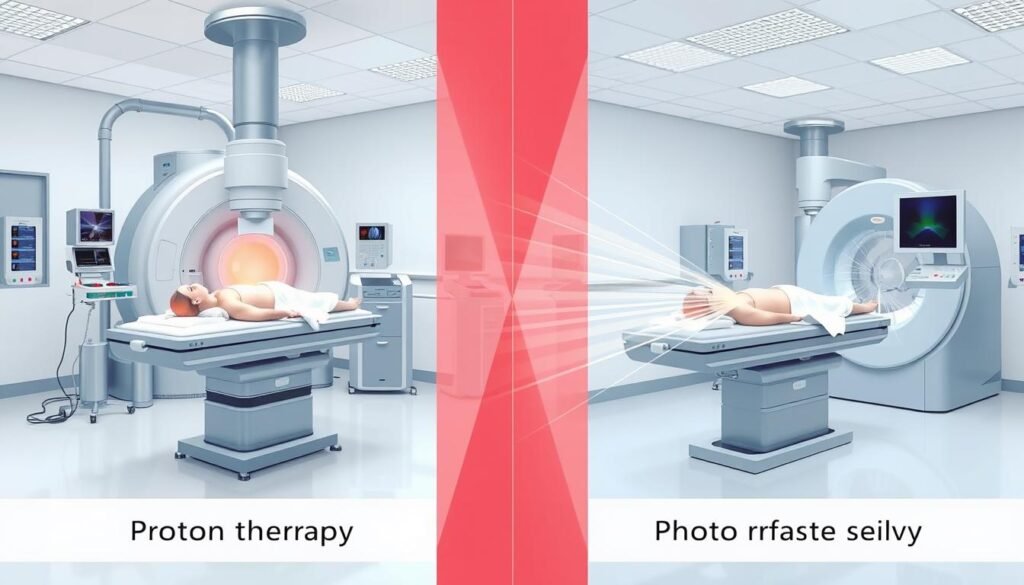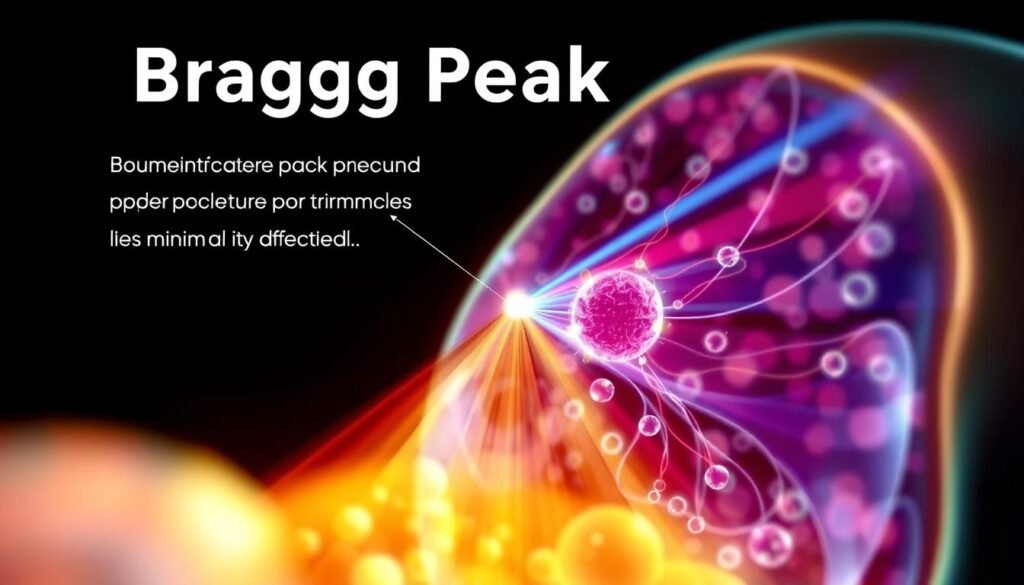Nearly 13% of cancer diagnoses in the U.S. are lung cancer. This high number shows how crucial effective treatments like proton therapy are. Proton therapy targets cancer cells precisely with charged particles. This means it spares healthy tissue around tumors. This cutting-edge method reduces risks and enhances treatment success for lung cancer patients.
This guide explains proton therapy, its benefits, and how it’s used in lung cancer treatment. Since 1988, proton therapy has been a key option for fighting cancer. It promises fewer side effects and better outcomes for patients.
Understanding the importance of protecting healthy tissue is key, especially in lung cancer. Smoking greatly increases the risk of lung diseases. Studies show quitting smoking cuts the risk significantly. Over 80% of lung cancer deaths in the U.S. are linked to smoking. To learn more about smoking risks, visit this resource.
Key Takeaways
- Proton therapy offers targeted radiation treatment for lung cancer, reducing collateral damage to healthy tissues.
- This therapy is designed to minimize exposure to critical organs, lowering risks of potential side effects.
- Pencil beam scanning technology enhances precision, ensuring effective tumor targeting.
- More than 200,000 patients globally have undergone proton therapy since its FDA approval.
- Clinical trials indicate that reducing radiation exposure to the heart significantly benefits lung cancer patients.
- Proton therapy can be an option for patients with existing health conditions or past cancer treatments.
- This treatment maintains similar efficacy in destroying cancer cells compared to traditional radiation methods.
Introduction to Proton Therapy
Proton therapy is a big step forward in treating cancer. It uses a type of advanced radiation treatment that focuses on positively charged particles, or protons. This method pinpoints tumor cells accurately. It avoids harming the healthy tissues nearby, which is crucial for tumors close to vital organs like the lungs or heart.
A typical proton therapy plan includes treatments five days a week for several weeks. Each visit aims for utmost accuracy. While the therapy itself takes only minutes, getting ready and positioned might lengthen the time in the treatment room to 15-30 minutes or more.
Introduction to proton therapy requires detailed planning. It starts with imaging tests like CT scans or MRIs to know the tumor’s exact location and size. The team adjusts the proton beam for the right dose and direction to hit the tumor effectively. Physicists check everything carefully to keep the treatment precise.
Proton therapy has clear benefits, like fewer side effects and a lower chance of secondary cancers. However, there are hurdles. Not many treatment centers are available in the U.S., making it hard for some patients to get this therapy. The cost of the specialized equipment and the extensive preparation can also make it less accessible. Insurance coverage varies a lot, so knowing the costs and fitting them into a budget is key.
Overall, proton therapy stands out as an advanced cancer treatment choice. It’s especially useful for complex cases. By focusing on the tumor and sparing healthy tissue, it’s a cutting-edge approach in combating cancer.
Understanding Proton Therapy in Lung Cancer Treatment
Proton therapy is changing how we treat lung cancer. It targets tumors while keeping healthy tissues safe. Definition of proton therapy: it uses high-energy protons to hit cancer cells with precision. Thanks to technologies like Pencil Beam Scanning, this method can pinpoint tumors with incredible accuracy, less than a millimeter off. This precision is much better than older ways.
Definition and Mechanism
This method works thanks to something called the Bragg Peak. It focuses the radiation right on the tumor. This means less radiation hits healthy organs. Proton therapy systems, like the one at Beaumont, match up with 3D imaging. This ensures patients get treatment that’s just right for them.
Comparison with Traditional Radiation Therapies
Compared to older radiation methods, proton therapy stands out. Traditional therapies might harm healthy tissue, leading to more side effects. But proton therapy targets only the bad stuff. It keeps critical areas like the heart and lungs safer, which is key for lung cancer patients. Studies show that those who get proton therapy with chemotherapy face fewer harmful effects than those who get standard X-ray treatments.
Lung cancer is a top cause of cancer deaths in the U.S. So, looking into proton therapy is important. New research keeps showing its benefits over old treatments. This helps improve how we fight cancer.
Benefits of Proton Therapy
Proton therapy is a rising star in lung cancer treatment, offering key advantages over traditional methods. It delivers radiation right to the tumor with high accuracy. This enhances treatment and patient experience significantly.
Minimized Radiation Exposure to Healthy Tissue
Proton therapy stands out because it minimized radiation exposure to healthy tissues. It targets tumors precisely, reducing damage to vital organs like lungs and heart. This can lower the risks of long-term side effects seen in conventional radiation therapies.
Potentially Fewer Side Effects
Proton therapy might lead to potentially fewer side effects compared to standard radiation. Studies show it causes less lung and esophagus inflammation. This means patients could have a smoother treatment with a better quality of life.
Similar Efficacy to Other Radiation Treatments
Proton therapy’s ability to target tumors while saving healthy tissue proves its effectiveness of proton therapy. It kills cancer cells as well as other treatments do, making it a strong option for patients. This focus on precision helps in treating lung cancer and other thoracic issues.
Proton Therapy vs. Photon Radiation
The way we treat lung cancer has changed a lot because of new radiation therapy techniques. Proton therapy and photon radiation are two different methods. It’s crucial to know how each one works. This helps doctors make the best choices for their patients.
Differences in Radiation Delivery
When comparing proton therapy and photon radiation, there’s a big difference in how they target tumors. Photon radiation uses x-rays and affects a wide area. This can harm healthy tissues around the tumor, causing side effects.
Proton therapy is different. It uses protons that hit the tumor directly. This limits damage to nearby healthy organs. So, patients are less likely to have complications. This leads to better outcomes.
Impact on Treatment Planning
For proton therapy to work well, doctors must use advanced imaging. This ensures the tumor is precisely targeted. Proton therapy has clear benefits over photon therapy. It can be more accurate, cause fewer side effects, and improve patients’ lives.
Choosing between proton therapy and photon radiation requires understanding these differences. This knowledge helps provide the best and most suitable care for each patient.

| Aspect | Proton Therapy | Photon Radiation |
|---|---|---|
| Type of Radiation | Protons | X-rays |
| Radiation Delivery | Precise targeting at tumor site | Broad distribution, affecting adjacent tissues |
| Impact on Healthy Tissues | Minimal exposure | Significant exposure |
| Treatment Planning | Advanced imaging required for accuracy | Less detailed due to broader fields |
| Potential Side Effects | Lower likelihood due to reduced radiation exposure | Higher possibility due to healthy tissue involvement |
Candidates for Proton Therapy
Proton therapy is a big step forward in treating lung cancer. It’s very important to choose the right candidates for proton therapy. This helps make sure the treatment works well and is safe.
Ideal Patients Based on Lung Cancer Stages
Ideal candidates for proton therapy usually have tumors that haven’t spread beyond the chest. For these patients, the therapy can be very helpful if their cancer has stayed put.
- Patients with solid tumors located near vital parts, like the heart, lungs, or spine
- Individuals who are getting chemotherapy
- Those facing cancer that has come back
- Pediatric patients at risk from traditional radiation effects
Proton therapy aims straight at the cancer, sparing the healthy parts around it. This makes it a better option for the listed patients.
Considerations for Patients with Existing Conditions
When thinking about considerations for patients with existing conditions, a thorough check-up is key. Patients with things like heart problems need a detailed look to see how proton therapy might affect them. This type of therapy is good because it doesn’t add extra risk to people already dealing with health issues, like poor lung function or past radiation.
Choosing the right candidates for proton therapy can lead to better lung cancer care. It lets doctors create treatment plans that really fit each patient’s health situation.
How Proton Therapy Works
Proton therapy is an advanced form of cancer treatment. It uses a principle called the Bragg Peak. This method targets tumors, protecting nearby healthy tissues.
The Bragg Peak Concept
The Bragg Peak concept focuses proton energy right on the tumor. This reduces the harm to important parts like the lungs and heart. Compared to standard therapies, it is more precise. It lets doctors aim cancer-fighting energy accurately. This cuts down the chances of cancer coming back and lessens complications for patients with certain cancers.
Pencil Beam Scanning Technology
Pencil beam scanning boosts proton therapy’s precision. It uses thin, exact beams to match the tumor’s shape. Doctors adjust the beam’s strength to target just the tumor. This spares the healthy tissue around it. This method improves treatment and may reduce side effects. Patients usually undergo treatment for six to seven weeks, with daily sessions lasting about 30 minutes.

Clinical Applications of Proton Therapy
Proton therapy is a modern, focused method for fighting cancer. It stands out in treating non-small cell lung cancer (NSCLC). NSCLC is common and aggressive.
Use in Non-Small Cell Lung Cancer
Proton therapy targets non-small cell lung cancer tumors precisely. It protects healthy tissue from too much radiation, especially near important chest organs. Focusing treatment on just the sick areas lowers the chance of treatment complications and other cancers. The Maryland Proton Treatment Center shows this approach helps lung cancer patients get better.
Combining with Chemotherapy and Surgery
Mixing proton therapy with chemotherapy and surgery is becoming a strong way to treat lung cancer. It can fit into detailed treatment plans, making them more effective. Patients have better chances of survival. This approach lets doctors craft custom treatments. It combines the strengths of proton therapy and other treatments. Doctors aim to improve how they handle non-small cell lung cancer.
Radiotherapy Side Effects and Management
Radiotherapy can have both short-term and long-term side effects. It’s important for patients to know about these effects. Knowing and preparing can help ensure treatment success. Proton therapy usually has fewer side effects. But being prepared is still essential.
Common Side Effects of Proton and Standard Radiation
The common side effects of proton therapy may include:
- Fatigue
- Difficulty swallowing
- Skin reactions
- Localized inflammation
- Shortness of breath
- Nausea and vomiting
How severe these radiotherapy side effects are can vary. Some patients have mild symptoms. Others might have a harder time. It’s essential to talk to your healthcare team about your symptoms.
Mitigation Strategies for Patients
There are ways to manage radiation side effects. Some suggestions are:
- Eat soft foods like soups and avoid spicy or very hot or cold foods.
- Drink plenty of water and eat well, possibly with specialized drinks recommended by dietitians.
- Stay away from alcohol to lessen irritation.
- Follow your doctor’s advice about medicines for pain, heartburn, and nausea.
- Talk to your healthcare team if you keep having side effects, like trouble breathing.
Getting the right support is important. Working with dietitians and doctors helps manage treatment challenges. By using these strategies, patients can feel better during treatment.

| Side Effect | Management Strategies |
|---|---|
| Difficulty Swallowing | Consume soft foods; avoid spicy meals. |
| Nausea | Use anti-sickness medication; try ginger. |
| Shortness of Breath | Maintain open dialogue with healthcare providers; use inhalers if prescribed. |
| Fatigue | Ensure adequate rest; engage in light physical activity. |
| Skin Reactions | Moisturize regularly; consult a dermatologist if severe. |
Proton Beam Delivery Systems
Proton therapy has changed cancer treatment for the better. It has advantages that traditional radiation doesn’t offer. The success of proton therapy depends on how it’s delivered. Knowing the different systems is key to understanding their effect on health results.
Overview of Different Systems Available
There are several proton beam delivery systems used in healthcare. Each one has its own special features. Here are the main types:
- Fixed Beam Delivery Systems: These aim proton beams at a set spot. They’re great for tumors in certain places.
- Rotating Gantry Systems: Doctors can angle the beams in many ways. This helps treat oddly shaped tumors better.
- Spot Scanning Systems: They use pencil beam scanning for pinpoint accuracy. This protects healthy tissue around the tumor.
Advancements in Treatment Delivery
New technology is making proton therapy even better. Real-time imaging lets doctors adjust treatments quickly as needed. This improves accuracy.
Adaptive delivery methods adjust the beam based on tumor movement. These advances promise better results for cancer patients. They lead to safer, more precise treatments.
Mayo Clinic Proton Therapy Program
The Mayo Clinic Proton Therapy Program is a leader in advanced cancer treatment. It’s managed by the only comprehensive cancer center in the U.S. recognized by the National Cancer Institute. You’ll find this program in Arizona, Florida, and Minnesota.
Overview of the Program
This program offers top-notch proton therapy using cutting-edge techniques. One key method is biological dose modeling, which helps target tumors precisely. It also uses in-room image guidance to protect healthy tissues around the tumor.
Pencil beam scanning is another innovative approach. It treats tumors close to vital organs with incredible accuracy. This method is especially beneficial for kids. Their growing bodies are more sensitive to radiation. Proton therapy helps them face fewer side effects later on.
Success Stories and Patient Testimonials
Patients often talk about how proton therapy has changed their lives. Many share success stories of their treatment at the Mayo Clinic. They highlight the caring atmosphere and the tailored care they receive from a team of experts.
This focus on each patient’s unique needs, along with advanced treatments, leads to better health outcomes. Interested in learning more? Visit this link for more information on their proton therapy services.
Conclusion
Proton therapy is changing the game in treating lung cancer. It focuses on being precise and safe. This makes it a standout choice for care.
One big plus is how it keeps the healthy tissue around the cancer safe from too much radiation. This means fewer side effects, which is great news. Experts are learning more all the time, and they’re finding that this method really works and makes patients happier.
Yes, it’s pricier than the usual treatments. But the costs of running these therapies are going down. And since it’s gentler on the body, it might end up saving money because of fewer side effects. People feel better emotionally and mentally, too, knowing their treatment is customized for them.
With tech getting better every day, proton therapy’s future is bright. New systems for planning and giving treatment are on the horizon. This means a lot of hope for those fighting lung cancer. They’re looking forward to care that not only works but also cares about their well-being.